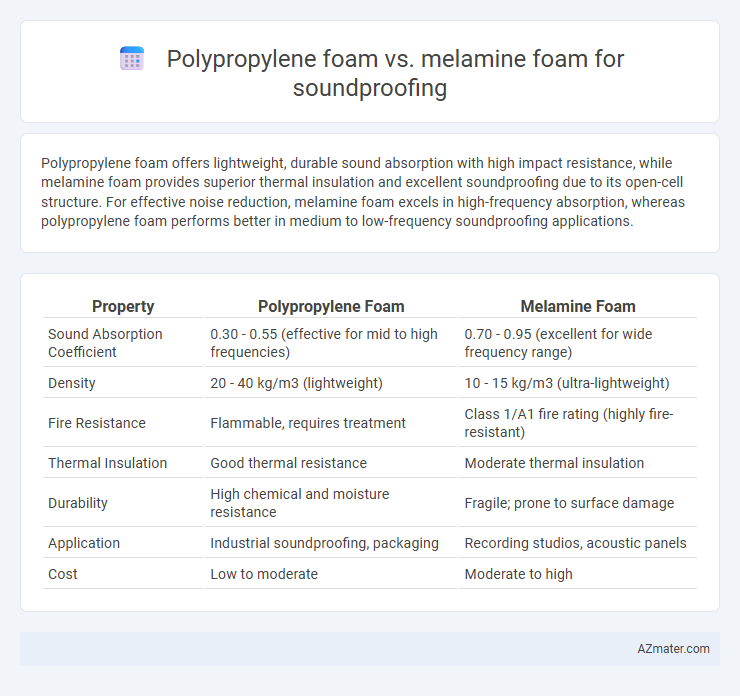Polypropylene foam offers lightweight, durable sound absorption with high impact resistance, while melamine foam provides superior thermal insulation and excellent soundproofing due to its open-cell structure. For effective noise reduction, melamine foam excels in high-frequency absorption, whereas polypropylene foam performs better in medium to low-frequency soundproofing applications.
Table of Comparison
| Property | Polypropylene Foam | Melamine Foam |
|---|---|---|
| Sound Absorption Coefficient | 0.30 - 0.55 (effective for mid to high frequencies) | 0.70 - 0.95 (excellent for wide frequency range) |
| Density | 20 - 40 kg/m3 (lightweight) | 10 - 15 kg/m3 (ultra-lightweight) |
| Fire Resistance | Flammable, requires treatment | Class 1/A1 fire rating (highly fire-resistant) |
| Thermal Insulation | Good thermal resistance | Moderate thermal insulation |
| Durability | High chemical and moisture resistance | Fragile; prone to surface damage |
| Application | Industrial soundproofing, packaging | Recording studios, acoustic panels |
| Cost | Low to moderate | Moderate to high |
Introduction to Polypropylene Foam and Melamine Foam
Polypropylene foam is a closed-cell, lightweight material known for its excellent acoustic insulation and high impact resistance, making it ideal for soundproofing applications in automotive and construction industries. Melamine foam, an open-cell, thermoset resin foam, offers superior sound absorption, fire resistance, and thermal insulation, often used in acoustic panels and noise control solutions. Both materials serve distinct soundproofing needs, with polypropylene foam providing durability and melamine foam excelling in noise reduction and fire safety.
Acoustic Properties: Sound Absorption and Transmission Loss
Polypropylene foam offers moderate sound absorption with a lightweight, open-cell structure that effectively reduces airborne noise but has lower transmission loss compared to denser materials. Melamine foam provides superior sound absorption due to its open-cell, rigid structure that traps mid to high-frequency sound waves and exhibits higher transmission loss, enhancing noise isolation. For applications requiring enhanced acoustic performance, melamine foam typically outperforms polypropylene foam in both sound absorption and transmission loss.
Material Composition and Structure Comparison
Polypropylene foam consists of a closed-cell structure made from a thermoplastic polymer, providing excellent impact resistance and moisture barrier properties, while Melamine foam is an open-cell network derived from thermoset melamine resin, known for its lightweight, fire-resistant, and high sound absorption capabilities. The dense, interconnected pores of Melamine foam enhance acoustic dampening by trapping sound waves, whereas the closed-cell construction of Polypropylene foam primarily offers thermal insulation and limited soundproofing. Material composition differences influence durability; Polypropylene's thermoplastic nature allows for flexibility and chemical resistance, contrasting with Melamine foam's rigid, brittle structure optimal for high-frequency noise reduction.
Thermal Insulation Capabilities
Polypropylene foam exhibits superior thermal insulation capabilities compared to melamine foam due to its closed-cell structure, which effectively reduces heat transfer and enhances energy efficiency in soundproofing applications. Melamine foam offers moderate thermal insulation but excels in sound absorption because of its open-cell, lightweight structure. When selecting between the two, polypropylene foam is preferable for environments where combined thermal insulation and soundproofing are critical.
Durability and Lifespan in Soundproofing Applications
Polypropylene foam exhibits superior durability and a longer lifespan in soundproofing applications due to its resistance to moisture, chemicals, and physical wear, making it ideal for environments with varying conditions. Melamine foam, while effective for acoustic absorption, tends to be more fragile and prone to degradation under mechanical stress or prolonged exposure to humidity. The enhanced structural integrity of polypropylene foam ensures sustained soundproofing performance over time, reducing the need for frequent replacements.
Fire Resistance and Safety Standards
Polypropylene foam offers moderate fire resistance, typically self-extinguishing under certain conditions, but it may produce toxic fumes when burned, requiring careful adherence to safety standards such as UL 94 V-0 ratings for flame retardancy. Melamine foam excels in fire resistance due to its inherent non-combustible nature, meeting stringent safety certifications like ASTM E84 Class A for flame spread and smoke development, making it a safer choice in environments demanding high fire safety. Both materials must comply with local building codes and fire safety regulations, but melamine foam's superior fire-retardant properties often position it as the preferred option for soundproofing applications in fire-risk-sensitive areas.
Installation Procedures and Flexibility
Polypropylene foam offers straightforward installation with its lightweight structure and easy cutting, making it ideal for custom soundproofing applications where flexibility is crucial. Melamine foam, while also lightweight, requires careful handling due to its brittle nature, and is typically mounted using adhesives or mechanical fasteners, which may limit installation flexibility. Both materials provide effective sound absorption, but polypropylene foam's adaptability and easier installation make it preferable for irregular surfaces and dynamic spaces.
Environmental Impact and Recyclability
Polypropylene foam offers significant environmental benefits due to its recyclability and lower carbon footprint compared to melamine foam, which is often non-recyclable and derived from petrochemical sources. Melamine foam's biodegradability is limited, leading to longer landfill persistence, whereas polypropylene foam can be reprocessed and reused, reducing waste. Choosing polypropylene foam for soundproofing supports sustainable practices by minimizing environmental impact through efficient lifecycle management and resource conservation.
Cost Analysis and Budget Considerations
Polypropylene foam offers a cost-effective soundproofing solution with moderate pricing, making it ideal for budget-sensitive projects that require durability and resistance to moisture. Melamine foam, while generally more expensive due to its superior acoustic absorption and fire-retardant properties, provides enhanced soundproofing performance for environments demanding higher noise control standards. Evaluating project scope and acoustic requirements is critical to balance upfront investment against long-term soundproofing efficacy and maintenance costs.
Best Use Cases: Polypropylene vs. Melamine Foam
Polypropylene foam excels in soundproofing applications requiring high impact resistance and durability, making it ideal for automotive and industrial noise control. Melamine foam offers superior acoustic absorption and fire resistance, which makes it best suited for recording studios, theaters, and office soundproofing. Choosing between polypropylene and melamine foam depends on specific requirements such as environmental conditions, noise frequency, and safety regulations.

Infographic: Polypropylene foam vs Melamine foam for Soundproofing
 azmater.com
azmater.com